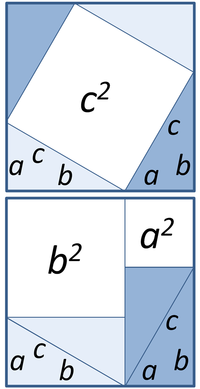
In mathematics, a theorem is a non-self-evident statement that has been proven to be true, either on the basis of generally accepted statements such as axioms or on the basis of previously established statements such as other theorems. A theorem is hence a logical consequence of the axioms, with a proof of the theorem being a logical argument which establishes its truth through the inference rules of a deductive system. As a result, the proof of a theorem is often interpreted as justification of the truth of the theorem statement. In light of the requirement that theorems be proved, the concept of a theorem is fundamentally deductive, in contrast to the notion of a scientific law, which is experimental.
Many mathematical theorems are conditional statements, whose proof deduces the conclusion from conditions known as hypotheses or premises. In light of the interpretation of proof as justification of truth, the conclusion is often viewed as a necessary consequence of the hypotheses. Namely, that the conclusion is true in case the hypotheses are true—without any further assumptions. However, the conditional could also be interpreted differently in certain deductive systems, depending on the meanings assigned to the derivation rules and the conditional symbol (e.g., non-classical logic).
Although theorems can be written in a completely symbolic form (e.g., as propositions in propositional calculus), they are often expressed informally in a natural language such as English for better readability. The same is true of proofs, which are often expressed as logically organized and clearly worded informal arguments, intended to convince readers of the truth of the statement of the theorem beyond any doubt, and from which a formal symbolic proof can in principle be constructed.
In addition to the better readability, informal arguments are typically easier to check than purely symbolic ones—indeed, many mathematicians would express a preference for a proof that not only demonstrates the validity of a theorem, but also explains in some way why it is obviously true. In some cases, one might even be able to substantiate a theorem by using a picture as its proof.
Because theorems lie at the core of mathematics, they are also central to its aesthetics. Theorems are often described as being "trivial", or "difficult", or "deep", or even "beautiful". These subjective judgments vary not only from person to person, but also with time and culture: for example, as a proof is obtained, simplified or better understood, a theorem that was once difficult may become trivial. On the other hand, a deep theorem may be stated simply, but its proof may involve surprising and subtle connections between disparate areas of mathematics. Fermat's Last Theorem is a particularly well-known example of such a theorem.
